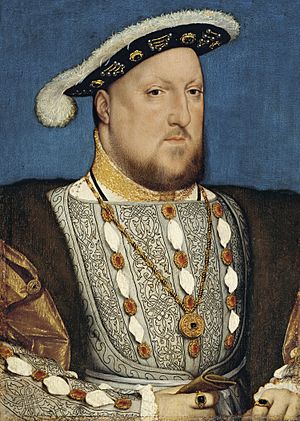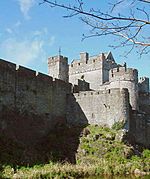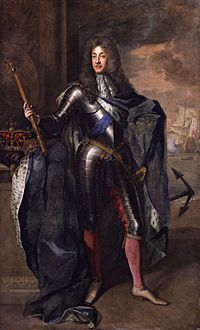History of Ireland (1536–1691) facts for kids
Ireland between 1536 and 1691 was a time of huge change. During this period, England took full control of the island for the first time. They also brought many Protestant settlers from Great Britain to live there.
This led to two major things that shaped Ireland's future:
- Ireland became controlled by governments in London.
- There was a lot of tension between Catholics and Protestants.
Before this time, much of Ireland was run by local clans and chiefs, following old Gaelic traditions. But by the end of this period, Ireland became a more centralized country, like other kingdoms in Europe. This era is sometimes called the early modern period in Ireland.
The period began in 1536 when King Henry VIII removed the powerful FitzGerald dynasty from their role as leaders in Ireland. In 1541, Henry VIII declared Ireland a new Kingdom of Ireland. The period ended in 1691, when Catholic supporters of King James II, called Jacobites, gave up at Limerick. This event confirmed that Protestants would be in charge in Ireland.
The English Reformation, which started in 1536 when Henry VIII broke away from the Pope, completely changed Ireland. While Henry VIII separated English Catholicism from Rome, his son Edward VI of England went even further, changing many Catholic beliefs. Most people in England, Wales, and later Scotland, became Protestant. However, most Irish people stayed Catholic.
Then, Queen Mary I brought England back to Catholicism from 1553 to 1558. But Queen Elizabeth I broke away from Rome again in 1559. These confusing religious changes deeply affected Ireland's relationship with Britain for the next 400 years. The English government tried to conquer and settle Ireland at the same time as these religious changes. This meant that native Irish people and the (Roman Catholic) Old English families could not hold power unless they became Protestant.
Contents
English Control and Rebellions (1536–1607)
Historians discuss why Henry VIII decided to fully conquer Ireland. One main reason was that the Fitzgerald family of Kildare, who had ruled Ireland for much of the 15th century, were no longer trusted by the Tudor kings and queens. For example, in 1487, they invited troops to Dublin to crown a fake king, Lambert Simnel. In 1535, Silken Thomas Fitzgerald openly rebelled against the King.
Henry VIII stopped this rebellion. He then decided to bring all of Ireland under English government control. He wanted to stop Ireland from being used as a base for foreign armies to attack England. This concern lasted for centuries.
Ireland changed from a "lordship" to a full Kingdom under Henry VIII. Since the 12th century, Ireland had its own Parliament of Ireland, with a House of Commons and a House of Lords. For a long time, Gaelic Irish people were not allowed to be members. Also, a law called Poynings' Law (1494) meant that the English King's advisors had to approve any new laws before the Irish Parliament could discuss them.
After 1541, Henry VIII allowed native Irish lords into both houses of Parliament. He also recognized their land ownership. In return, they had to accept him as King of Ireland. However, the real power in Ireland was not with the Parliament. It was with the Lord Deputy of Ireland, who was chosen by the King of England to govern Ireland. The Parliament only met when the Lord Deputy called it, usually to pass new laws or raise taxes.
With the government in place, the next step was to extend English control over all of Ireland. Henry VIII's officials used a plan called "surrender and regrant". They either negotiated or fought with the independent Irish Kings and lords. This process took almost 100 years and involved much fighting. It meant that many lordships that had been independent for hundreds of years became part of the English Kingdom.
The conquest was finished during the reigns of Elizabeth I and James I, after several bloody wars. The Desmond Rebellions (1569–1573 and 1579–1583) happened in the south of Ireland, in Munster. The Fitzgerald Earl of Desmond family fought against an English governor being placed in their area. The second rebellion was stopped by causing a severe famine, which may have killed a third of Munster's people.
The biggest threat to English rule came during the Nine Years War (1594–1603). In this war, Hugh O'Neill and Hugh O'Donnell, the most powerful chiefs in Ulster (northern Ireland), rebelled against the English government. This war became a revolt across the whole country. O'Neill and O'Donnell even got military help from Spain, which was fighting England at the time. However, Spanish forces were defeated by the English at the Battle of Kinsale in 1601.
O'Neill and his allies finally surrendered to the new King, James I, in 1603. After this, the English government in Dublin truly controlled Ireland for the first time. They brought a single system of justice to the whole island and successfully disarmed the various local lords. O'Neill, O'Donnell, and their allies then left Ireland for good in the Flight of the Earls in 1607. This removed the last major challenge to English rule in Ireland.
Settlement and Religion
The English did not have much success in converting either the Irish leaders or the Irish people to the Protestant religion. It's a big question why the Protestant reformation didn't take hold in Ireland. One reason is that the English government used harsh methods to control the country and use its resources. This made Irish people resent English rule even more.
Also, Catholic priests, many of whom had studied in Europe, actively worked to keep people Catholic. Irish Colleges were set up in Catholic European countries to train Irish Catholic priests and educate Irish Catholic wealthy families. Finally, the printing press, which helped spread Protestant ideas in Europe, arrived in Ireland very late.
From the mid-1500s to the early 1600s, the English government started a policy of colonisation called Plantations. Scottish and English Protestants were sent as settlers to the areas of Munster, Ulster, and the counties of Laois and Offaly. The biggest of these projects was the Plantation of Ulster. By 1641, about 80,000 English and Scots had settled in northern Ireland. These settlers, known as Ulster Scots, were mostly Presbyterian, which made them different from the Anglican English settlers.
These new settlers, who saw themselves as British and Protestant, became the ruling class in Ireland. A series of Penal Laws were put in place. These laws discriminated against all Christian faiths except the official (Anglican) Church of Ireland. The main groups affected were Roman Catholics and, later, Presbyterians.
From 1607, Catholics were not allowed to hold public office or serve in the army. In 1615, the voting areas for the Irish Parliament were changed. This was done so that Protestants would always have a majority of votes in the Irish House of Commons. The Catholic majority in the Irish House of Lords lasted until 1689, except during the time of the Commonwealth of England (1650–60).
A New Start? (1607–1641)
In the early 1600s, it seemed possible that Ireland could become a peaceful part of British society because of the many English and Scottish settlers arriving. However, this didn't happen. The English authorities continued to discriminate against Irish Catholics because of their religion.
Before Queen Elizabeth's time, the Irish population was usually divided into the "Old (or Gaelic) Irish" and the Old English. The Old English were descendants of medieval settlers from England. These groups had often been enemies. English-settled areas like the Pale around Dublin and other walled towns were fortified against the rural Gaelic clans.
However, by the 17th century, the differences between these groups were fading, especially among the upper classes. For example, most Old English lords spoke the Gaelic language and supported Irish poetry and music. Marriages between the groups were also common. After the English conquest, the native population became united by their shared Roman Catholicism. This set them apart from the new Protestant British settlers and the official Protestant British government in Ireland.
In the decades between the end of the Elizabethan wars in 1603 and the start of the rebellion in 1641, Irish Catholics felt more and more threatened and discriminated against by the English government in Ireland.
Most of the Irish upper classes did not oppose the King of England ruling Ireland. They wanted to be full citizens of the three Stuart kingdoms (England, Scotland, Ireland) and keep their important place in Irish society. But their Catholic religion and the threat of more Plantations prevented this. The Protestant-dominated government in Ireland tried to take more land from native landowners. They questioned old land titles and punished people for not attending Protestant church services.
In response, Irish Catholics appealed directly to the King, first to James I and then Charles I. They asked for full rights as citizens and for their religion to be tolerated. This plan was known as The Graces. Several times, the Kings seemed to agree to their demands in return for higher taxes. However, Irish Catholics were disappointed when, after paying the taxes, the King delayed fulfilling their requests.
By the late 1630s, Thomas Wentworth, King Charles's representative in Ireland, was planning even more widespread land seizures from native Irish families. This was meant to break the power of the Irish Catholic upper classes. It's likely this would have caused armed resistance from Irish Catholics at some point. But the actual rebellion started because of a political crisis in Scotland and England, which led to civil war in all three kingdoms.
Wars, Land Loss, and Penal Laws (1641–1691)
The fifty years from 1641 to 1691 saw two terrible periods of civil war in Ireland: 1641–53 and 1689–91. These wars killed hundreds of thousands of people and forced many others to leave the country forever. The wars, which pitted Irish Catholics against British forces and Protestant settlers, ended with the Catholic landowning families losing almost all their property.
The Confederate War and Cromwell's Conquest
In the mid-1600s, Ireland was torn apart by eleven years of war. It began with the Rebellion of 1641. Irish Catholics, feeling threatened by the growing power of the anti-Catholic English Parliament and Scottish Covenanters, rebelled against English and Protestant control. The uprising, started in Ulster by Féilim Ó Néill, led to widespread violence. Most Irish Catholic lords and their followers then joined the rebellion.
In some ways, the rebellion was the result of Irish Catholics feeling mistreated by English policies for a long time. However, it was sparked by the fear of civil war breaking out across all of Britain and Ireland.
The rebellion included several massacres of Protestant settlers, especially in Ulster. This event left deep scars on relations between communities in Ireland for centuries.
Because the English Civil War started in 1642, no English troops were available to stop the uprising. The rebels ended up controlling most of Ireland. The Catholic majority briefly ruled the country as Confederate Ireland (1642–1649) during the wider wars in Britain and Ireland. The Confederate government allied with King Charles I and the English Royalists. If the Royalists had won the English Civil War, Ireland might have become an independent Catholic-ruled country.
However, the Royalists were defeated by the Parliamentarians. Charles I was executed. Then, Oliver Cromwell re-conquered Ireland between 1649 and 1653 for the English Commonwealth. Cromwell's conquest of Ireland was marked by terrible acts, such as the killing of the Royalist soldiers at the Siege of Drogheda in 1649. Another policy was sending prisoners of war to the West Indies. Even worse, Parliamentarian commanders used a "scorched earth" policy to defeat Irish guerrilla fighters, which caused famine across the country.
As punishment for the 1641 rebellion, almost all lands owned by Irish Catholics were taken away. They were then given to British settlers. The remaining Catholic landowners were forced to move to Connacht in the west of Ireland. (See also Act of Settlement 1652). Also, Catholics were completely banned from the Irish Parliament. They were forbidden to live in towns and from marrying Protestants (though not all these laws were strictly enforced). It's estimated that up to a third of Ireland's population (400,000 to 600,000 people) died in these wars, either from fighting, famine, or disease. Cromwell's conquest left very bitter memories in Irish history.
Restoration
A difficult peace returned when the monarchy was brought back in England. Charles II tried to make things better for Irish Catholics with some compensation and land grants. (See also Act of Settlement 1662). However, most Catholics were disappointed that the land taken by Cromwell was generally not returned. Protestants, on the other hand, felt that Charles had been too easy on Irish Catholics. They believed Catholics deserved to be punished for the massacres of Protestant civilians in 1641.
In 1678, there was another short period of anti-Catholic actions during the Popish Plot. It was rumored that Irish Catholics were planning another rebellion with help from France. Two Catholic Bishops, Peter Talbot and Oliver Plunkett, were arrested. Talbot died in prison, and Plunkett was executed.
The War of the Two Kings
However, within a generation of the monarchy's return, Ireland was at war again. When the Catholic King James II of England came to power, Irish Catholics briefly seemed like they might regain their important position in Irish society. James removed many anti-Catholic laws. He allowed Catholics into the Irish Parliament and the Army. He also appointed a Catholic, Richard Talbot, 1st Earl of Tyrconnell, as Lord Deputy of Ireland. Protestants in Ireland could do little about these changes.
However, in 1688, the "Glorious Revolution" happened. James II was removed from power by the English Parliament. He was replaced by William of Orange, with help from a Dutch invasion force. Irish Catholics supported James. They hoped he would reverse the Penal Laws and return their confiscated lands. Irish and British Protestants supported William. They wanted to keep their power in the country.
Richard Talbot, the Lord Deputy, gathered a Jacobite army from among Irish Catholics. They took control of most strongholds around the country, except for Derry. Derry was then besieged by James's men. James, supported by the French King Louis XIV, arrived in Ireland in 1689 with French troops. The Siege of Derry was broken when General Percy Kirke arrived with a relief force.
The same year, Marshal Schomberg landed with a large Williamite army and captured Carrickfergus. He then moved south to Dundalk. The two armies faced each other for a long time before going into winter camps. The next year, William III landed at Carrickfergus with many more troops, including British, Dutch, and Danish soldiers.
The two Kings fought for the English, Scottish, and Irish thrones in the Williamite War. The most famous battle was the Battle of the Boyne in 1690, where James's forces were defeated. This battle was not the end of the war, but it is remembered as a great Williamite victory. This is because James fled Ireland for France after the battle, basically admitting defeat to William.
However, Jacobite resistance in Ireland continued for another year. They had a success at the Siege of Limerick. But the war finally ended after the Battle of Aughrim in July 1691, when their main army was destroyed. They surrendered at Limerick shortly after. The Jacobite army left the country under the terms of the Treaty of Limerick, negotiated by Patrick Sarsfield. They went to serve in the French army. This war, though not as destructive as the 1640s, was a crushing defeat for the old Irish Catholic landowning classes. They never got back their former power in Irish society.
Protestant Power
Penal Laws (which had been relaxed a bit after the English monarchy was restored) were brought back with great strictness after this war. The Protestant leaders wanted to make sure that the Irish Catholic landowning classes could not rebel again. In fact, many new Penal Laws were introduced. These laws put restrictions on Catholics inheriting property. As a result, Catholic land ownership fell from about 14% in 1691 to about 5% over the next century.
Also, from 1704, Presbyterians were also banned from holding public office, carrying weapons, and entering certain jobs. This was partly because the mostly English Anglican leaders did not trust the mostly Scottish Presbyterian community, which had become a majority in Ulster. By the end of the 17th century, about 25% of Ireland's population was Protestant. Anglicans made up about 13% of the population and formed the ruling Protestant Ascendancy.
For information on the 18th century, see Ireland 1691-1801.
See also




